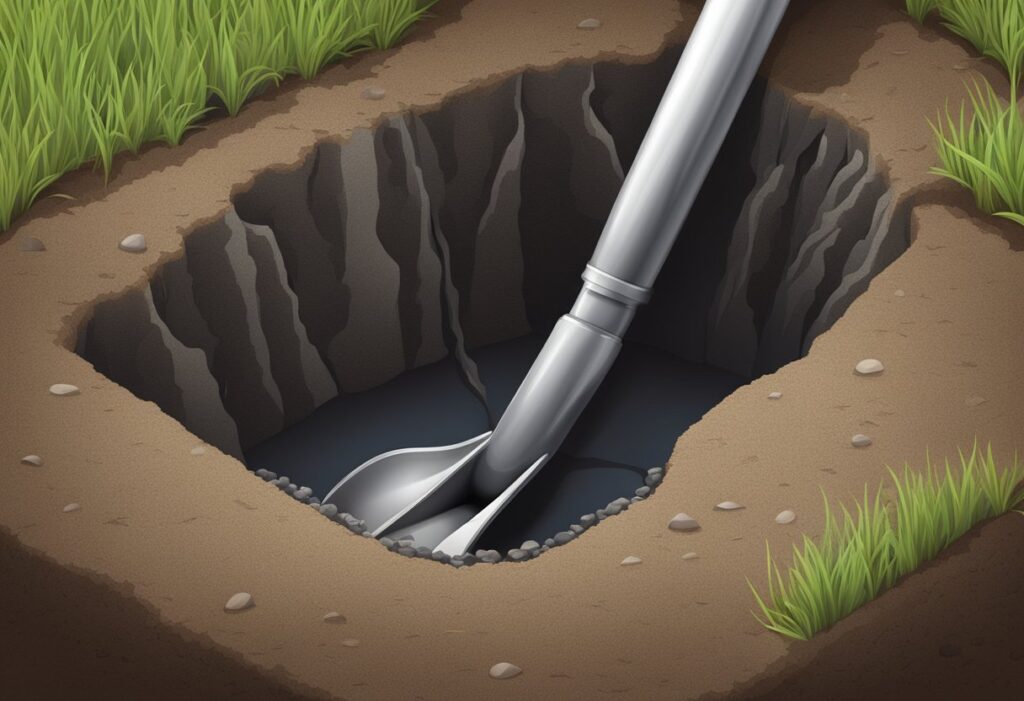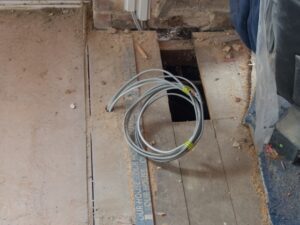Finding your sewer line might sound tricky, but it doesn’t have to be! The key is knowing where to look.
For most homes, sewer lines are located in basements, crawl spaces, or garages, often marked by a four-inch pipe with a screw cap.
This is your first clue for locating your sewer system within the house. Look carefully—there may also be a small notch or square knob on top of the cap.
Once you’ve found this access point, the next step is to trace the sewer line outside your home. The easiest way is to check your property’s blueprints or contact local utility services. Many offer services that mark underground utilities for you, helping you pinpoint the location of your sewer line without the guesswork.
In cases where you want to be more hands-on, tools like a pipe locator can be incredibly helpful. These devices give you a more precise look at where the line runs.
At Excel Mechanical, we understand how essential it is to find your sewer line without causing damage or unnecessary digging. If you need expert guidance or assistance, our team is always ready to help you locate and maintain your plumbing system effectively.
In this blog, you will learn:
- How to identify your sewer line’s access point and locate it inside your home.
- Tools and services that can help you accurately trace your sewer line without unnecessary digging.
- Steps to take when you’re unsure about locating your sewer line, including when to consult a professional.
Without further ado, let’s get started.
Understanding Sewer Lines
Sewer lines are critical in managing wastewater from your home or business.
Learning about the different types and components of sewer systems can help you better maintain and troubleshoot your plumbing.
Types of Sewer Systems
Several types of sewer systems are designed to handle wastewater in specific environments.
- Gravity Sewer Systems rely on the land’s natural slope to move wastewater without mechanical assistance. They’re common in residential areas due to their simplicity and cost-effectiveness.
- Pressure Sewer Systems use pumps to move wastewater when gravity alone isn’t enough. These are ideal for areas with flat terrain or when wastewater needs to be transported uphill.
- Lastly, Vacuum Sewer Systems use differential air pressure and are typically found in cities where conditions demand such technology.
Understanding these systems helps you decide which one best suits your property. Regular maintenance ensures efficiency, whether you have a gravity-fed system or a more complex setup.
Components of a Sewer Line
Sewer lines contain various key components, each vital to effective wastewater management.
- The Main Line transports waste from your home to the municipal sewer, handling the largest volume. Regular inspections help prevent clogs and backups.
- Vent Pipes release gases and maintain air pressure, preventing toxic gas build-up within your home. Keeping them clear ensures proper ventilation and fluid movement.
- Other parts include cleanouts, which provide access to clearing obstructions.
- Traps use water to block sewer gases from entering your living spaces.
These components work together to ensure your sewer line functions smoothly. Regular maintenance and inspections by professionals help detect potential problems before they become serious, saving you time and money.
Locating Your Sewer Line
Several methods are used to help you locate your sewer line accurately. Most importantly, identifying the sewer line can save you time, effort, and potential costs associated with plumbing issues.
Using Property Maps
Property maps are a valuable resource for locating sewer lines.
These maps often show detailed layouts of utility lines, including water and sewer lines. To access them, check with your local municipality or city planning office. They can usually provide copies or direct you to an online database.
Sometimes, home inspection reports or documents provided during your home purchase might include property maps. Look for diagrams or blueprints that specify utility paths. By identifying these paths, you can better understand where your sewer line is located underground.
Visual Indicators in Your Yard
Visual clues in your yard can also guide you to your sewer line.
Look around the house exterior for cleanout pipes. These pipes typically have round, plastic caps and can be spotted near the foundation or visible exit points for sewer lines.
Sometimes, the pavement or landscaping features like trees and large shrubs might indicate the sewer line path, as these features could be planned around existing underground utilities.
Remember to avoid digging without proper identification to prevent damaging the pipes.
Professional Sewer Line Locators
If you can’t find the sewer line using maps or visual clues, it may be time to call in professionals.
Companies like Excel Mechanical are experts in this field, providing accurate and efficient services to locate sewer lines. Professionals use specialized equipment such as pipe detectors and cameras to pinpoint exact sewer line locations.
Using professional services ensures safety and reduces the risk of accidentally damaging your property.
We are renowned for quality and value, offering HVAC and plumbing solutions tailored to residential and commercial needs. Relying on experts can provide peace of mind and save unnecessary expenses.
DIY Sewer Line Locating Tips
Finding your sewer line requires checking certain areas and using some essential tools.
This guide focuses on identifying cleanout pipes and efficiently detecting the path of your sewer line. These steps will help you address various issues and plan repairs or maintenance.
Identifying Cleanout Pipes
To start, search for cleanout pipes around your home.
These are vital since they offer direct access to the sewer line.
- They often appear as capped pipes, typically about four inches in diameter.
- Look for them in the basement, garage, or near the foundation of your house. C
- leanout pipes can sometimes be found outside, close to the home’s exterior walls.
- In many cases, these pipes have a cap marked “cleanout.”
- Take note that they might be hidden by plants or landscaping.
- A flashlight can help you inspect darker areas to make the pipes easier to spot.
Clear access to these pipes is important for inspection and potential maintenance tasks.
Detecting Sewer Line Path
Once you find the cleanout, you can trace the sewer line’s path. It generally runs directly to the street or a septic tank in the yard. Utility locating tools, such as a pipe locator tool, can assist in tracing.
These devices help detect the exact location of the pipes and minimize guesswork. Marking the ground as you trace can help you keep track of the path. It’s a good idea to double-check your findings to confirm accuracy.
Preventive Measures and Maintenance
Conduct regular inspections and take steps to prevent damage to keep your sewer lines in good shape and avoid costly repairs. By following these methods, you can ensure a well-functioning system and extend the lifespan of your sewer lines.
Regular Inspections
Scheduling consistent inspections is crucial for detecting early signs of cracks or blockages.
Using a professional service to conduct these checks helps identify problems before they escalate, saving you time and money. Specialized equipment can detect blockages and assess your pipes’ general condition, ensuring everything is in working order.
Set up a timeline to have your sewer lines inspected periodically. This proactive approach lessens the likelihood of unexpected breakdowns.
Avoiding Sewer Line Damage
Be mindful of landscaping choices to protect your sewer lines from damage.
Avoid planting trees or large shrubs near sewer lines, as roots can infiltrate and cause blockages. Implementing root control measures is effective in preventing these issues.
Additionally, be cautious about what goes down your drains. Non-biodegradable items can cause significant clogs and backups. Encourage mindful usage of household drains and consider installing strainers to catch debris.
When to Call a Professional
Sometimes, finding your sewer line can be tricky. It might involve digging or using special tools. If you feel stuck or unsure, getting help from a professional is a good idea.
Signs You Need Help:
- Strange Odors: Persistent bad smells might mean a blocked sewer line.
- Slow Drains: If all your drains are slow, it can signal a problem deeper in the system.
- Water Backups: Recurring water backups require immediate attention.
If these issues persist, don’t hesitate to call in experts.
Benefits of Hiring a Professional:
- Expertise: Professionals have the knowledge and tools to find and fix the problem quickly.
- Safety: Trying to locate or fix a sewer line yourself can lead to accidental damage.
For reliable and efficient service, consider Excel Mechanical. We offer top-notch plumbing services, ensuring quality work at a great value. Our team can handle both residential and commercial needs.
Why Choose Excel Mechanical:
- We tailor solutions to fit different needs and budgets.
- Our commitment is to deliver exceptional service and value.
Trusting professionals means your sewer line issues will be resolved safely and efficiently. When problems arise, don’t hesitate to seek the help you need.
Legal Considerations and Compliance
Important legal factors to consider when it comes to sewer lines include easements that may affect your ability to access or alter your sewer line and regulations that guide how repairs are handled.
Understanding Easements
Easements are legal rights that allow others to use a portion of your property for a specific purpose. This can include access to sewer lines. These rights could be held by utility companies, the city, or neighbors. Knowing if there’s an easement on your property is crucial.
Easements can affect where you can dig or build. Before you start any sewer line work, you should verify if an easement exists. Checking property deeds or contacting local government offices can help you find this information.
Understanding easements can prevent potential legal issues. Missteps can lead to fines or lawsuits, so being informed is key. If you’re unsure, consider hiring a lawyer to review property documents.
Sewer Line Repair Regulations
Regulations for sewer line repairs can vary widely depending on where you live.
Local governments often have rules about who can perform repairs and what materials can be used. These regulations ensure that work is done safely and effectively.
Permits are often required before starting any sewer line repair. Securing a permit can help you avoid legal troubles down the road. You should always hire a licensed professional for this work. This ensures compliance and protects your property.
Excel Mechanical offers highly qualified experts to handle all your HVAC and plumbing needs. With a focus on exceptional quality and value, partnering with us ensures your compliance with all necessary regulations.
Frequently Asked Questions
Looking to understand more about your sewer line? Here are some common questions and answers to help you navigate the process of locating and maintaining your sewer lines, ensuring your system runs smoothly and efficiently.
How can I locate the main sewer line in my residence?
The main sewer line is usually connected to a sewer cleanout point. This is a capped pipe near your house or an outdoor plumbing fixture. Removing the cap can help trace the pipe route.
Where can I obtain city maps indicating sewer line locations?
Your local municipal office often holds city maps showing sewer lines. By contacting them, you may gain access to public records detailing these locations, which can give a clearer view of the overall sewer network.
Is there a way to access maps showing sewer lines for my specific property free of charge?
Sometimes, municipalities provide free access to property maps. You can inquire at your city hall or engineering department. Online databases may also offer such maps, depending on your location.
How do I identify the sewer line route from my house to the street?
Besides looking at home blueprints, contacting a utility company can help. They might send professionals to mark the path. Alternatively, services like utility marking can mark the location for you.
How can you determine the depth at which sewer lines are buried?
Depth information is usually included in property plans or can be found by calling utility services. Sewer lines are often buried at least two to six feet underground, but this can vary depending on location and frost line.
What steps should be taken to locate underground drain pipes on my property?
Start with property records and utility maps. Using a pipe locator or hiring professionals can also be effective. Our brand, Excel Mechanical, provides expert services in locating and maintaining sewer lines. We offer exceptional quality and value in both residential and commercial services.




